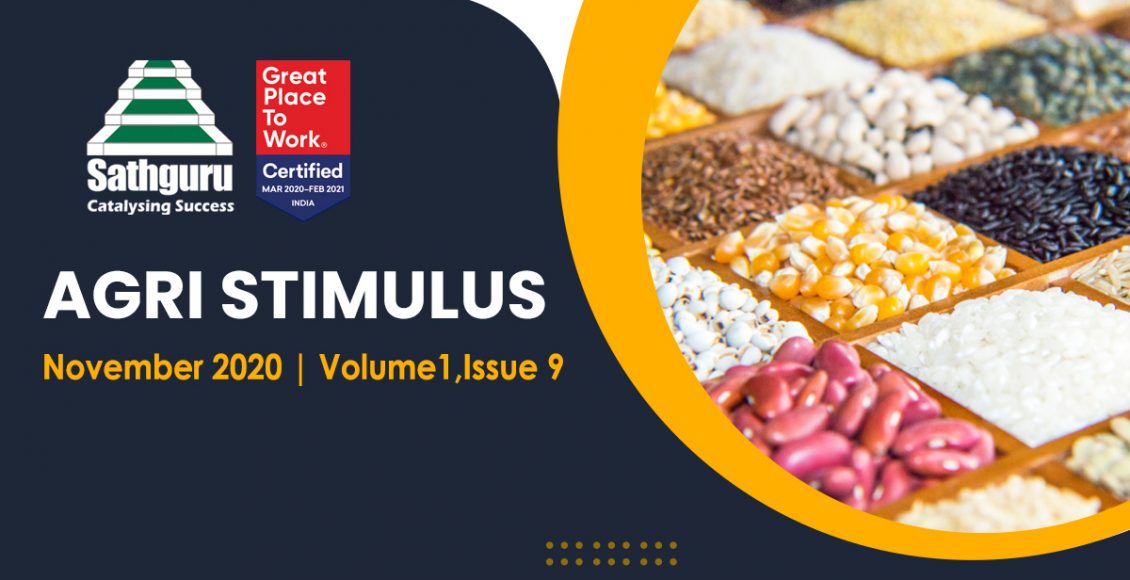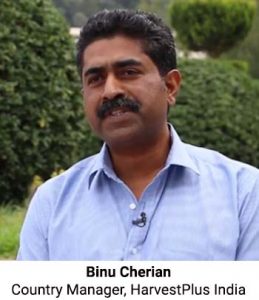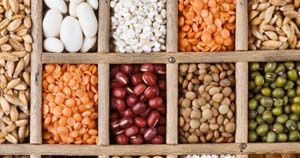
Underutilized crops for improving nutritional security
Asafoetida Cultivation in India – A promising business opportunity!
Adoption of biofortified crops through PPP model
Biofortification: A Transformative Innovation to Unlock Agriculture for next Nutrition Revolution
Message from HarvestPlus
“HarvestPlus, a global program under Agriculture for Nutrition and Health (A4NH) of  Consultative Group for International Agriculture and Research (CGIAR), that improves nutrition and public health by developing and promoting biofortified food crops that are rich in vitamins and minerals, providing global leadership on biofortification evidence and technology.”
Consultative Group for International Agriculture and Research (CGIAR), that improves nutrition and public health by developing and promoting biofortified food crops that are rich in vitamins and minerals, providing global leadership on biofortification evidence and technology.”
Globally, more than two billion people did not have regular access to nutritious and sufficient food in 2019, this trend will affect people’s health, especially diets of women and children, according to The State of Food Security and Nutrition in the World 2020 (SOFI 2020) report. Stunting rates in India is about 38%, and anemia affects about 65 -70% of the preschool children and women. COVID 19 pandemic situation has brought renewed focus to healthy and nutritious food that is cost-effective, safe, locally accessible, and food supply chain resilience.
Staple foods form a major share of the resource-poor population’s daily diet, which provides energy requirements, but they do not provide most of the micronutrients required for healthy living. An affordable, diverse diet rich in micronutrients is still a challenge to many of the resource-poor population. By enhancing the micronutrient content of the energy‐rich staples, intakes of micronutrients can be increased.
Biofortification is a process of enhancing micronutrients in the staple food crops that people consume daily, developed by conventional breeding methods. They have all the traits that the farmers desire to grow, high in yield, disease resistance, and a measurable health impact on the populations when eaten daily. The advantages of biofortification are that it starts in the rural areas, it is cost-effective and sustainable. The focus of the program is on three micronutrients, iron, zinc, and vitamin-A, that are considered limiting in the diets of the resource-poor population, according to the World Health Organization (WHO). Biofortification has the potential to complement the existing interventions like fortification and supplementation to create far more impact. Biofortification was ranked fifth by the expert panel at the Copenhagen Consensus 2008.
HarvestPlus has developed partnerships with CGIAR centers- ICRISAT, CIMMYT, IRRI, ICARDA; ICAR, SAUs, Seed Companies, FPO’s and NGO’s for product development and dissemination. The focus of the program in India is on zinc-rich wheat, zinc-rich rice, and ironrich pearl millet that are major staples for millions. Seven hybrids, one variety of iron-rich pearl millet, and four zincrich wheat varieties have been developed in the partnership program. Ironrich pearl millet is grown in Maharashtra, Rajasthan, Haryana and Karnataka. Zinc -rich wheat is grown in UP, Bihar, and Punjab.
Agri-Food Value Chains and Enabling Agri-Policies for greater impact:
There are a growing market and shift of the health-conscious consumer space for naturally nutritious, healthy, wholesome foods and ingredients. Agri-Food partnerships can help to leverage investments, technology, and capacities to overcome the gaps in the existing supply chains for nutritious crops, help in creating traceability of raw materials supply, last-mile capabilities, systems, and processes to meet the supplydemand imbalance.
On the occasion of World Food Day, 16th October 2020, Prime Minister Shri. Narendra Modi dedicated biofortified crops to the nation. Prime Minister also stressed in this speech the plans to incorporate biofortified crops in the existing food and nutrition program (Midday Meal, PDS, ICDS, etc.), which can enhance the nutritional component of the food programs. These AgricultureNutrition linkages can create demand and incentivize farmers to increase the adoption of biofortified crops.
Conclusion
More than 50 million people globally consume and benefit from eating biofortified crops in Asia, Africa, and Latin America. In India, an estimated 640,000 people, are benefiting from growing and eating iron-rich pearl millet and zincrich wheat. The mission of HarvestPlus is to reach One Billion people by 2030. To leap and reach these numbers requires innovative partnerships across the value chain.
Developing long-term sustainable markets for biofortified crops will require public and private investments and partnerships to accelerate further product development and wider reach of biofortified seeds to farming communities. Enabling agriculture policies for promoting Agri-Nutrition linkages will help in sustainable production and demand creation. Agri-Food partnerships have the potential to create greater efficiencies across the value chain for biofortified crops.
Biofortification, a novel agriculture technology, has the potential to spur the next nutritious revolution towards Kuposhan Mukt Bharat.
Acreage of Rabi sowings increases by 10% compared to previous year : Overall acreage of all Rabi crops put together recorded an increase of nearly 10 % compared to same period last year mostly coming from increased sowing of pulses this year. Farmers have sown pulses across large area and has risen to 8.25 million hectares from 6.45 million hectares last year. Read More
Ensuring MSP to the farmers by tweaking policies: To achieve the goal of ensuring that the farmers receive the right prices for their products and at least receive the MSP from the market every season, Government has been tweaking the import and export policies to maintain sufficient stocks of commodities and has also been using the buffer stock to control market prices. Read More
FMCG and food processing companies come together to solve stubble burning issue in North India : To tackle the recurring stubble burning issue in North India, firms like PepsiCo, DCM Shriram, ITC, and CII are closely working with farmers of Haryana, Punjab, and Rajasthan on sustainable farming practices and aim at addressing stubble burning issue effectively. The firms are engaged in providing field trainings, and encouraging the use of alternate practices and adopting advance agriculture practices to address the problem of stubble burning. Read More
ICRISAT permitted for deployment of drones for agricultural research activities : With drones set to play a big role in the sector through precision agriculture, pest management, yield enhancement the government is currently encouraging research for developing low cost drone based solutions. This permission will help in operationalization of the Digital Sky Platform. The condition has been granted for 6 months (or under completion of task whichever is earlier) a set of stipulated conditions and limitations. Read More
Advanced countries receive agri-machinery from India : In 2019-20, India exported 76.41% of its total agri-machinery export to North America, Eastern Europe, EU,UK, Africa, ASEAN and SAARC. Among these exports, tractors accounted for 66% of the total shipments of agri-machinery. Read More
Indo – Israel collaboration to utilize latest technology and boost farmer income: Proposal for setting up two centers of excellence to boost the farmers' income by utilizing the latest technology has been discussed. The collaboration will facilitate knowledge sharing of best agricultural practices from Israel with North-eastern region farmers to boost their income. Read More
Sugarcane growers to benefit with government considering export subsidies for 20-21 season : Extension of export subsidy for sale of sugar in international markets will be welcome move for the industry given the bumper sugar production expected for the current season. Higher export volumes of sugar will help in ensuring that the domestic rates do not fall below cost of production and thus growers getting paid by the millers. Read More
Decline in India’s tea production pulled down the global black tea output over 5% : Lockdown and adverse weather conditions in North Indian plantations has pulled down the global black tea output in the three quarters of the current calendar. The global black tea production has fallen to 1570 million kg from 1660.72 million kg for the same period last year. India has contributed the largest share in this decline. Read More
Centre nods for subsidised loans for implementing micro irrigation projects: The steering committee of micro irrigation fund (MIF) has approved projects for loan worth Rs 3,971.31 crore. Subsidised loans are provided for not only taking up special and innovative projects but also for incentivizing micro irrigation to encourage farmers to install micro irrigation systems. Maximum loan has been approved for Tamil Nadu followed by Haryana, Gujarat, Andhra Pradesh, West Bengal, Punjab and Uttarakhand. Read More
10% likely increase in fertilizer sales for Rabi season than previous year : With good soil condition for Rabi cultivation, stable prices of raw material and enhanced domestic production of fertilizer during the pandemic, the sales of fertilizers are expected to rise for the upcoming Rabi season 2020 – 21. Farmers have already started procuring fertilizers from August onwards and with stable prices the sales are increasing. Read More
Click here to Download the PDF version
Authors:




Connect with Authors at: E-mail agribusiness@sathguru.com
 Grow Beyond
Grow Beyond 





